Sarajevo: Art , Culture and War
24 April, 2008, 01:06 am in "Bosnia and Herzegovina"
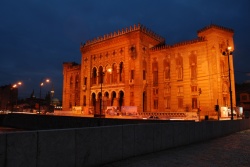 The train track to Sarajevo from Mostar follows along a river gorge with mountains of dark gray rock which were folded and layered like some kind of giant torte. The mountains were covered with a calico pattern of dark pine trees and light deciduous leaves. The tops were obscured by the clouds which looked like cobwebs waiting to be swept away by the sun. The jade green of the river was muted to more of a dusty lichen color. In the distance on the tops of the higher mountains, the rain had turned into snow.
The train track to Sarajevo from Mostar follows along a river gorge with mountains of dark gray rock which were folded and layered like some kind of giant torte. The mountains were covered with a calico pattern of dark pine trees and light deciduous leaves. The tops were obscured by the clouds which looked like cobwebs waiting to be swept away by the sun. The jade green of the river was muted to more of a dusty lichen color. In the distance on the tops of the higher mountains, the rain had turned into snow.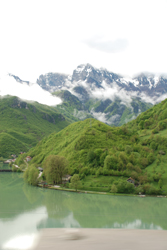
The towns were sparsely scattered houses, some new ones built right next to the ruins of the old. Sometimes, in large towns, huge identical concrete apartment buildings loomed over the other houses. It seems these artifacts of communist architecture managed to survive the war.
Our first impression of Sarajevo was... ugly. The location, surrounded by hills with a river (now brown) running through it was pretty, but it seemed to just be a sprawl of modern buildings and lots of concrete towers.
After lunch we went to the Tunnel Museum. The museum was the house of the Kolar family who had preserved artifacts from the war and the tunnel project. Edis and Bajro Kolar (father and son) had both been Bosnian soldiers at the time.
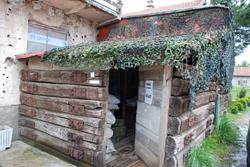
We were shown a video of Sarajevo during the war and what the residents had to try to live through. Then the video showed the construction of the Tunnel. The following information was gleaned from the museum brochure:
On April 15, 1992, the Yugoslavian Army and local Serbian militias began a siege on the city of Sarajevo. Water, electricity, communication and supplies were cut off. In July of 1992, the UN made an agreement with the Yugoslavian Army to take control of the airport in order to deliver humanitarian aide. Citizens tried to use the runways to escape from the city or reach supplies or communication channels but the UN would turn them back to the city if they were caught. Furthermore, while running through the fields and trenches, they were shot at by snipers. Close to 800 people were killed trying to bring food to their families, meet their loved ones, bring weapons for defense, or to escape to freedom from the hell of Sarajevo.
So, in the beginning of 1993, the Bosnian army and volunteers began to construct a tunnel to connect the city with the outside world. In July '93 it was finished. This tunnel stretched 800 meters and served as a lifeline for the people of Sarajevo: an oil pipeline, electric cable and food were passed through the tunnel... as well as 1000s of people. The tunnel kept many people of the town alive through the 2 remaining years of the siege following the tunnel's completion.
Under a structure next to the house is 5 meters of one end of the tunnel which is open to tourists. A large part of the tunnel collapsed under the airport runway but efforts are being made to restore the complete tunnel fully.
Although the tunnel itself wasn't the most fascinating thing to look at, it was definitely worth visiting something that was so instrumental in saving the lives of so many people.
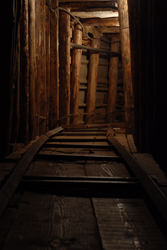
Once back in the center, we walked to the Ottoman quarter of town-- a pleasant pedestrian area with small shops selling... well... things you'd find in a Turkish bazaar. There were several mosques and a stone Ottoman market where the stalls had been replaced by shiny glass store fronts housing boutiques. There was also a quaint street where metal workers made hammered metal pieces like trays and cezves for Turkish coffee. They also made ornate pieces from old shells.
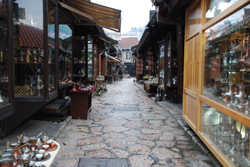
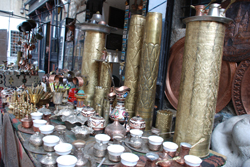
To my delight, there were numerous cafes and cake shops where a delicious piece of cake or baklava costs about 1 dollar and a shot of espresso, 75 cents. Though tempted to spend the whole day (especially since it was raining) sampling all the different cakes, we restrained ourselves and between downpours viewed the shelled ruins of the Old Town Hall (The National Library), the outside of the Gazi Husrev Bey Mosque, and the other sights in Bascarsiya, the Ottoman quarter.
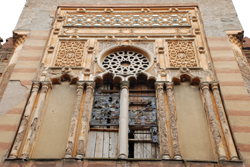
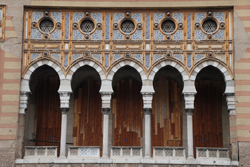
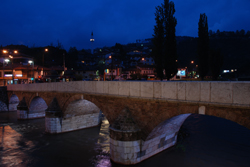
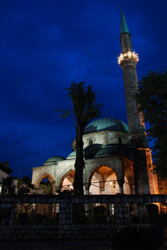
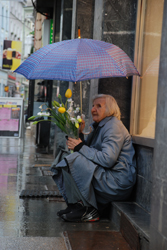
All this Ottoman stuff made us a bit homesick for Istanbul. So, since we found a good priced plane ticket to Istanbul, the next day we bought the last 2 seats on a 14:45 flight. We spent the rest of the morning wandering around the Ottoman quarter, having Turkish (Bosnian) coffee, and taking a walk to the fortress on the hill which over looks a graveyard full of white gravestones marking soldiers graves.
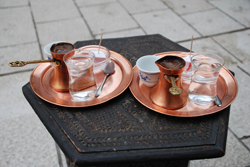
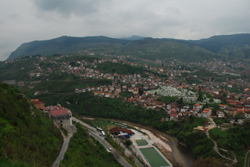
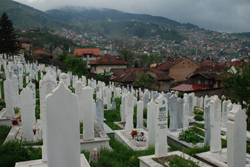
When we had walked into the center, we had come across a giant strawberry in front of the cathedral.
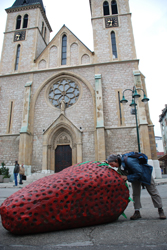
Walking back we came upon a giant orange in front of a WWII war memorial and later an apple in a park... none of which had been there the previous day.
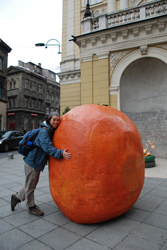
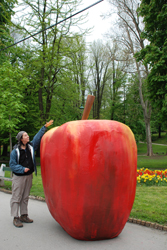
My favorite piece of Sarajevo art, though was a crazy human powered moving musical sculpture. There were pedals and wheels that when turned looked like they made metal ears flap and bellows blow air into giant horns. It looked like a lot of fun but the moving parts had been locked so the sculpture didn't work.
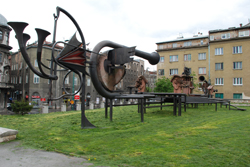
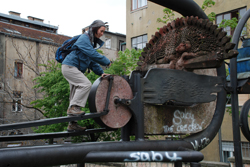
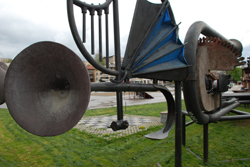
Bosnia is extremely proud of its multi-culturalism. We found a sculpture expressing this sentiment in a square. It was called "The Multicultural Man Builds the World".
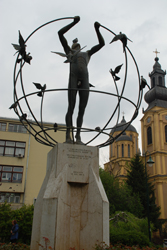
In the same square there was a giant chess game taking place.
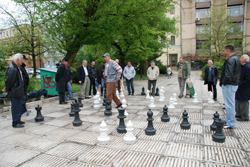
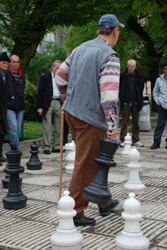
On a main pedestrian street we heard accordion music and saw the performer was one of 3 kids Rowshan had made friends with the night before.
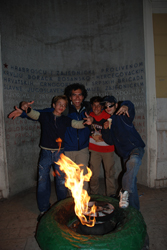
We listened a little and gave him 3 marks. His eyes widened in disbelief but he tried to hide the smile that was creeping across his lips. A little farther down, a little girl was singing gypsy songs. We gave her a mark. Ermin, the accordion player walked up and when I asked if she was his sister, he said yes. They happily disappeared down a street either for lunch or perhaps they had made their required amount for the day and were able to go play.
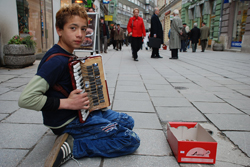
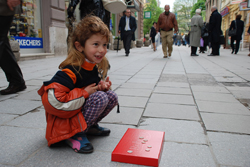
We collected our bags and hailed a taxi to the airport. The taxi driver was an older man playing a CD with old recordings of Bosnian music--75 to 100 years old he said. He said he was a musician and showed us a photo of his band on a business card.
We talked about how wonderful traditional music is. Rowshan played the driver some Bosnian songs from his Ipod and he was delighted. “Ah! I know this song. I play this!” He showed us a CD from his friend from Finland who is an ethnomusicologist. Soon we reached the airport. He said if we were ever in town again to call and we could play music together.
Mostar: A Broken Town Reunited
22 April, 2008, 03:33 am in "Bosnia and Herzegovina"
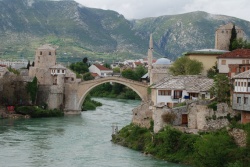 One thing about pouring rain and gray skies is they make the green countryside look even greener. As we turned inland from the beach resorts and pristine towns, and arrived in Bosnia, the towns began to look a lot less prosperous. There were many new buildings, but the awful fact was that they were replacing homes destroyed during the war. Occasionally we saw stone ruins in the distance but couldn't be sure if they were ancient or modern.
One thing about pouring rain and gray skies is they make the green countryside look even greener. As we turned inland from the beach resorts and pristine towns, and arrived in Bosnia, the towns began to look a lot less prosperous. There were many new buildings, but the awful fact was that they were replacing homes destroyed during the war. Occasionally we saw stone ruins in the distance but couldn't be sure if they were ancient or modern.The other obvious differences were the tall minarets which began to rise from the hills. As the bus reached Mostar and we passed bullet and shrapnel laced walls mixed with new or repaired buildings.
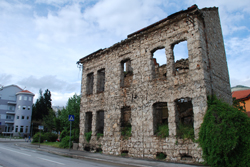
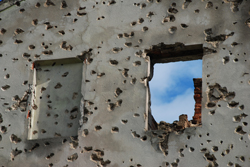
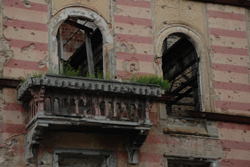
At the bus station, instead of the chaotic bidding for our accommodation Euros, each one of us was presented with a card from a different woman. When they learned we were together, one card was withdrawn, leaving us one choice. The other women all helped this woman, speaking well of her room and helping translate. Of course, we were told, if we didn't like the room we could come back and see another. After settling us in, our hostess quickly returned to the station where I assume she helped the other women find boarders. It seemed like a very positive and cooperative situation.
We walked through the town to the old part, past a building with huge blackened holes and metal structural supports twisting out like wires from a damaged machine.
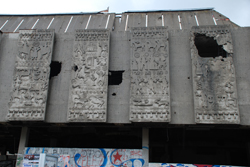
The new part of town had mostly repaired buildings housing cafes, restaurants and slick stores.
The old town was completely unexpected for me. Suddenly we were on a pedestrian street paved with rounded river stones which ran between little stone houses with roofs shingled with flagstones which from a distance resembled fish scales. Though most of the shops sold tourist kitsch, there were also some cute cafes and art galleries. Walking down the street we could hear the sound of hammers against metal, shaping the copper relief bridge pictures sold in the shops.
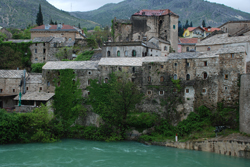
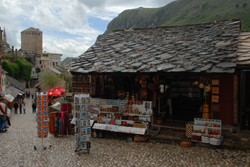
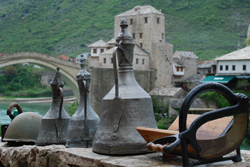
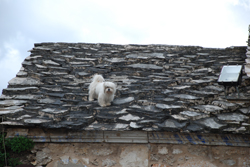
Domes of Ottoman mosques and minarets rose above the roofs. From the street level the town slipped into lush plant life which lined the river. Under the cloud cover, the river was the color of jade and rushed and boiled with the spring run off.
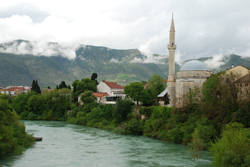
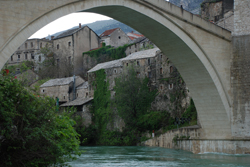
At the far end of the old town is the moon-like white arch of the ”most” (bridge) of Mostar. This iconic landmark is actually a rebuilt version of the Ottoman bridge, one of the 12 remaining in Bosnia before the war, which was destroyed. The town was quick to work together to rebuild it making it a metaphor for a community destroyed by war and how they came together afterward to rejoin the halves of the town and their lives. Young men of the town, members of the bridge diving club, would jump off the bridge in to the swift, cold water when paid enough by tour groups.
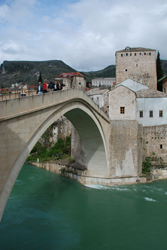
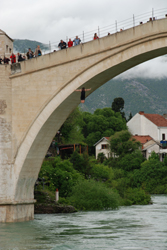
The old town looked almost as good as new, which was, in fact, true since it had mostly been destroyed during the war. The buildings had been rebuilt in the original manner. I also noticed a couple mosques which had been demolished in the 50s-60s and rebuilt after the war, as well, to look like the originals.
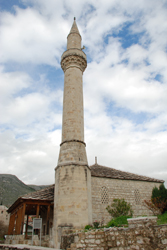
Down a quiet path, we found a miniature tributary of the river flowing to join the Neretva. Over this was a small Ottoman bridge (also rebuilt). It had a sign that said Luxembourg had restored it. Other buildings had signs that a Swedish organization had rebuilt them.
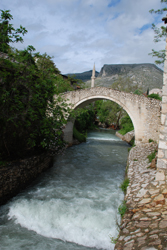
Though the city is still very scarred, it looks like it is healing. People seemed very kind and friendly. It was tempting to stay just for the atmosphere, good food, and great Turkish coffee and baklava.
On one street we found a bombed and ruined building with a spray painted picture of Cartman (from South Park). “Oh my God! They killed Kenny!” was scrawled above showing that someone in town had a dark sense of humor.
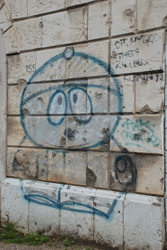
We saw a hill with a trail up it. Since Mostar was a war zone, hiking in areas without commonly used trails is not recommended due to the possibility of mines or undetonated shells.
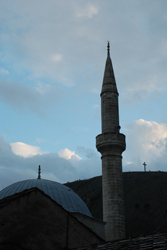
The trail had a path through the weeds so we determined it was actively in use and would give us a nice view of the town. Rowshan was about to cut across some property to get to the path when I noticed red tape that said “Mine!” Grabbing Rowshan, I pointed this out. He in turn pointed out that it was an occupied apartment building and the tape was in fact covering a hole in a fence where a car had driven off the road. “They probably had extra.” I considered that it could also mean, “Mine!” as in “Not Yours!”. Either way, we decided it was better to go around to the path via the road.
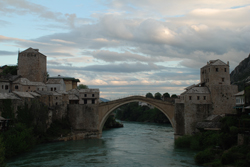
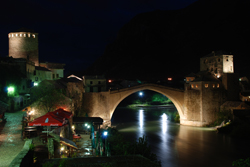
[ View 1 Comments
|
]
Dubrovnik: Walls and Water
21 April, 2008, 00:33 am in "Croatia"
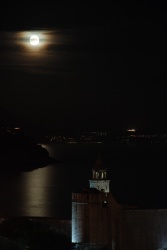 Grey woolly clouds hid the sky over the hills and ocean, as we left Split. The bus ride followed the coast, which was mostly large expanses of emerald trees ripped by white rock. The sea, in spite of the gray sky, managed to keep its jewel-like color, only slightly muted. Below the patches where the sky managed to find a hole in the clouds, the sea would flash turquoise and the land would seem to glow like a brief smile.
Grey woolly clouds hid the sky over the hills and ocean, as we left Split. The bus ride followed the coast, which was mostly large expanses of emerald trees ripped by white rock. The sea, in spite of the gray sky, managed to keep its jewel-like color, only slightly muted. Below the patches where the sky managed to find a hole in the clouds, the sea would flash turquoise and the land would seem to glow like a brief smile. At the bus station, still out of view of the legendary old town, we were surrounded by people offering rooms. I selected one who said she had an apartment with a private bath and shared kitchen (shared with other boarders), 15 minutes walk from the old town.
"She lies!" another woman shouted. "It's far!" "50 minutes is more like it!" a man added. I just wanted to get away from all the people pushing cards and photos of their rooms at me. Rowshan wanted to look at other options. Eventually he joined our host and I but had to remove a woman who was clinging to him.
The room was nice, newly made and clean but it took us about 20 minutes to walk to the old town and longer to get back since the apartment was up a hill. We decided it was fine.
Our first walk into town worried us since we couldn't see the town until we were there due to the way the street ran and the houses around the stairways we walked down. When we saw it, it looked formidable with strong curving walls and large buildings.
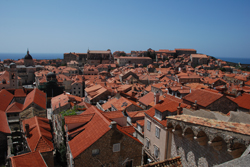
Where Split is built into ruins of the ages, from Roman through Medieval, Dubrovnik is a fortified, Renaissance town. The buildings boast several stories and the town looks well maintained and restored. We entered through a gate with a niche where a statue of the guardian of the city stood.
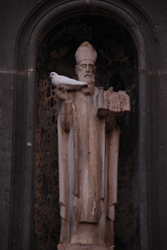
The restoration, it turns out was all done in the last 10 years, since the old town was severely damaged during the Yugoslavian war in the 90s. A large sign at one of the entrances showed all the parts that were damaged, some by direct hits, others by fire or shrapnel. A sticker had been stuck at the top of the sign read "Ubit Srbia", "Kill Serbia" showing all is not forgiven.
The old town is car free and its streets are full of tourists. The main street is spacious with narrower streets leading in straight lines off of it. Several apartment lined stairways led steeply up from the center of town to the outer walls, many gracefully lined with potted plants.
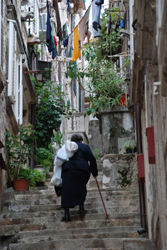
Through the Northern gate, there is a water tower where women sell crafts as well as some interesting stone carvings on the buildings surrounding it.
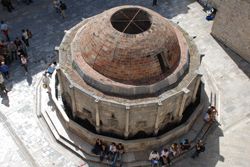
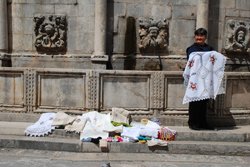
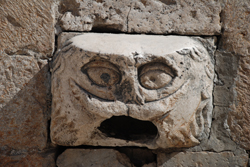
At dusk we walked up the hill next to the old town, looking for a good view of the town. The weather covered the town in a gauzy haze. It looked silent. As we walked, the evening lights were gradually turned on, green around the outer walls, white and gold inside, turning the gray stones silver. The town looked like a piece of jewelry resting on a dark blue velvet ocean. A silken breeze brushed against us as we watched the city.
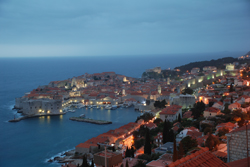
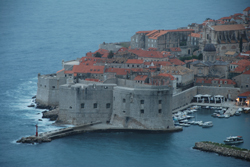
Dubrovnik Walls
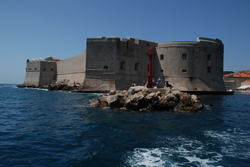
The old city of Dubrovnik is surrounded by almost 2 km of heavy stone walls which in some places reach a height of 25 meters. The strong but graceful walls also contain a couple fortress towers as well as many watch towers. From the walls, one has a perfect view of the inner town, whose tile roofs and stone walls resemble a mosaic below, as well as stunning vistas of the sea and the hills above the town.
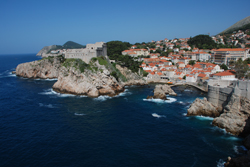
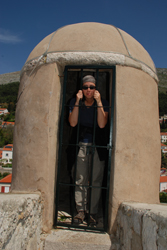
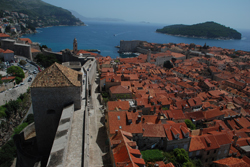
The buildings of the town seem safe and secure, nestled inside the towering walls, but with modern weapons, the Serbian and Montenegrin armies were probably able to sit far above in the hills and easily fire upon the town. From that point of view, the town looked like a wounded seabird, unable to fly into the hills and unable to swim away into the
sea.
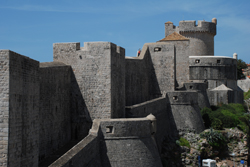
It was a perfect day for walking the walls.
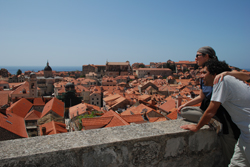
The sky was cloudless and the smell of orange blossoms overpowered the smell of the sea. One of the first sites we could see was the Fort Lourijenac, outside the walls, perched on towering rocks which were dusted with spring plants. The deep turquoise blue sea gnashed at the base with white foam teeth which stood out against the otherwise calm sea.
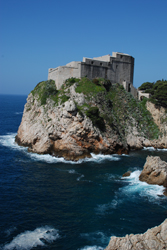
We continued on, looking down at peoples' yards and gardens full of orange, lemon and lilac trees, as well as lush green vegetables and orange poppies. Laundry was strung on lines stretching from buildings to the walls.
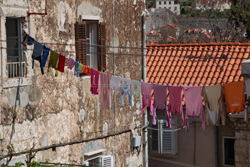
Some people had built grape arbors where grape vines had begun to twine. Occasionally we'd see one of the many Dubrovnik cats sunning themselves on white stone or crouching in the grass or flowers.
The walk progressed upward until we stood high on the walls closest to the sea, which were perched up on steep cliffs. Then the walls curved around so we could view the island of Lokrum and the harbor. Church towers, domes, and bell towers rose from the city. Though there were already lots of people roaming the streets, the city seemed silent except for soft church bells and birds singing.
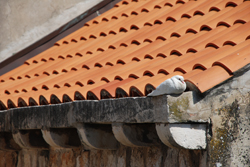
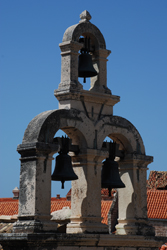
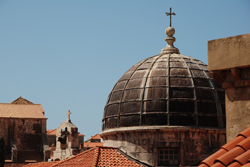
Eventually we reached the back stretch with views of the steep apartment and plant lined streets into the city. At various points of the walls, we'd seen ruined buildings, sometimes transformed into gardens.
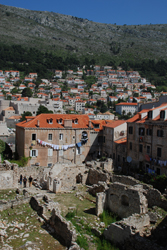
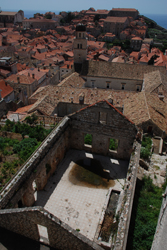
After the walls, we caught a boat to Lokrum, wanting to take full advantage of the weather. Lokrum is about a 20 minute boat ride away. The island is completely covered with trees, except for the edges which are made up of white-gray rocks lined and cracked like elephant skin.
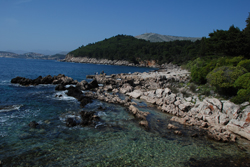
We were soon walking completely alone through the forest and along the beach. People aren't allowed to stay over night on the island, however, there is a huge population of semi-feral peacocks who occupy the place. People leave piles of crumbs for them. One woman who must have been a regular had a whole flock start running after her when they caught site of her. She produced bags of crumbs and some other peacock treats.
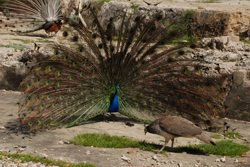
Following some peacocks, we found ourselves overlooking a protected cove filled by water from the ocean through a cave. We waded a little but found the water icy. A peacock scolded us loudly, his neck was about the same color as the water.
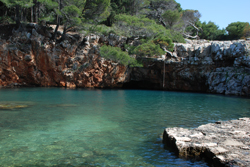
Leaving the "Dead Sea", as it was called, we visited the ruins of a 12th century Benedictine Monastery, then climbed to the top of the island for a view from Fort Royal, which was built by the French Occupation in the early 1800s.
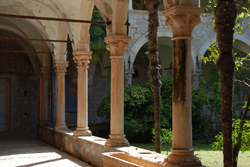
Time had managed to slip by quickly on this slow peaceful island and we soon had to scurry down the path to catch the last boat to town.
In the evening Rowshan went out to take night pictures of the town.
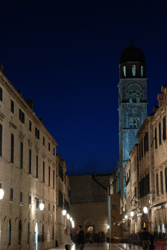
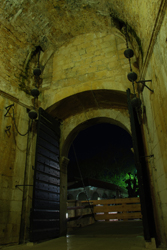
Our last day in Dubrovnik was overcast so we hiked up a couple staircases into the hills, then up a rougher stairway which led to a path through rocky parkland to Bosanka, a village above Dubrovnik. There we saw some feral goats.
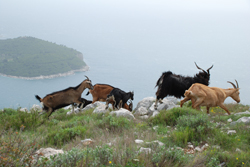
Here we began to see more blatant war damage lacking in the restored lower town: ruins of buildings as well as graves with dates like b. 1970 d. 1993. A painful reminder that the soldiers killed were roughly the same age as I was.
The top of the hill had a huge white cross with an alter but no names or explanation. Beyond that were the twisted ruins of a chairlift and another ruined building.
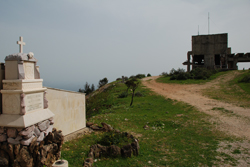
Both had burnt out holes where they'd been hit during the war. Nature had attempted to cover these wounds of war with plant life. A little farther off was another grave of 3 soldiers. A strong wind gave the shredded metal chairlift mechanism a voice and it creaked and sighed.
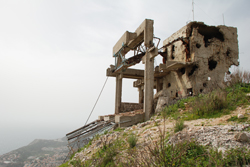
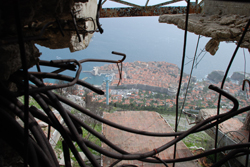
We descended into town and walked some more, noticing a church with a bullet scar and another semi-ruined building.
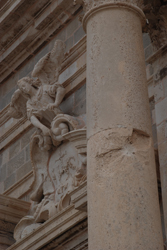
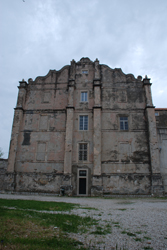
In the evening, the sky turned rose casting the ocean into a lavender haze.
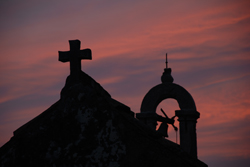
Powered by My Blog 1.69. Copyright 2003-2006 FuzzyMonkey.net.
Created by the scripting wizards at FuzzyMonkey.net..
(Code modified by Rowshan Dowlatabadi)
Created by the scripting wizards at FuzzyMonkey.net..
(Code modified by Rowshan Dowlatabadi)

